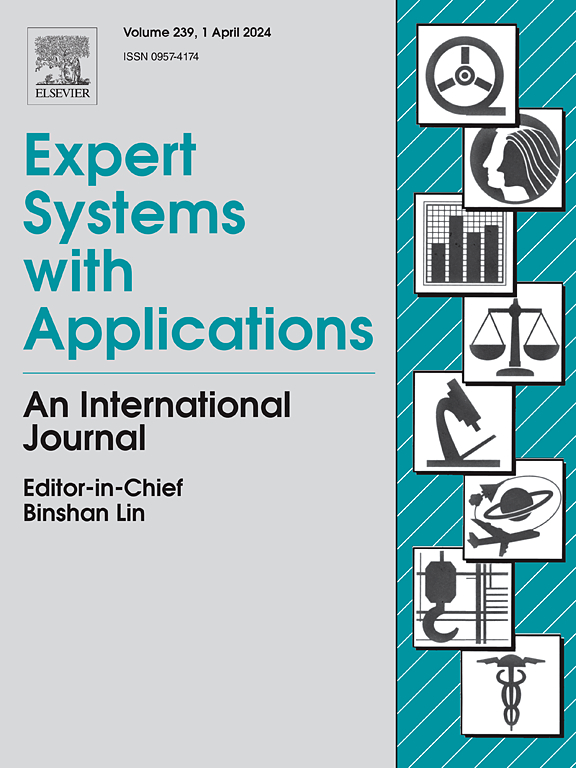利用包含二次插值和精英群遗传算子的金枪鱼群优化算法对水稻植株图像进行多级阈值分割
IF 7.5
1区 计算机科学
Q1 COMPUTER SCIENCE, ARTIFICIAL INTELLIGENCE
引用次数: 0
摘要
水稻植株图像在不同的生长阶段和环境条件下呈现出不同的纹理特征。一种合适的图像阈值分割方法可以有效分离水稻植株的不同特征区域,从而更好地监测水稻生长情况,提高产量。本文采用 Sigmoid 非线性权重策略、二次插值策略和精英群遗传策略来增强金枪鱼群优化算法(TSO)的不同阶段,提出了 SQGTSO 算法,该算法具有更好的收敛性和全局优化能力。实验结果表明,在9个基准函数中,SQGTSO算法优于其他算法。为了评估 SQGTSO 用于水稻植株图像多级阈值分割的可行性和有效性,本文选取了 8 幅风格各异的水稻植株图像设计了两组对比实验。SQGTSO 算法与 7 种先进的元启发式算法和 1 种机器学习方法进行了综合比较。在阈值从 4 到 30 的条件下,设计了两组不同的实验。在每个实验集中,分别采用大津方法和 MCET 方法作为元搜索算法的适配函数。评估标准包括适度值、PSNR、SSIM、FSIM 和 HPSI。此外,还利用弗里德曼方法对每种算法得出的五个指标进行了统计分析。实验结果表明,与其他竞争者相比,SQGTSO 方法在五个评估指标及其收敛性能方面具有显著优势。本文章由计算机程序翻译,如有差异,请以英文原文为准。
Multilevel threshold segmentation of rice plant images utilizing tuna swarm optimization algorithm incorporating quadratic interpolation and elite swarm genetic operators
Rice plant images exhibit varying texture characteristics across different growth stages and environmental conditions. A suitable image thresholding segmentation method can effectively separate the different feature regions of rice plants for better monitoring of rice growth to improve yield. This paper employs the Sigmoid non-linear weights strategy, Quadratic interpolation strategy, and elite swarm Genetic strategy to enhance distinct stages of the Tuna Swarm Optimization algorithm (TSO) to propose the SQGTSO algorithm, which has better convergence and global optimization capability. 10 CEC2017 benchmark functions are selected to validate the performance of the SQGTSO algorithm, and the experimental results show that the SQGTSO algorithm outperforms the other algorithms in 9 benchmark functions. To assess the feasibility and efficacy of the SQGTSO for multilevel threshold segmentation of rice plant images, this paper selects 8 rice plant images with diverse styles for the design of two sets of comparative experiments. The SQGTSO algorithm is comprehensively benchmarked against seven advanced metaheuristic algorithms and one machine learning method. Under the conditions of threshold levels ranging from 4 to 30, two distinct experiment sets are devised. In each set, Otsu’s method and the MCET method are employed as fitness functions for the metaheuristic algorithms, respectively. The assessment criteria include fitness values, PSNR, SSIM, FSIM and HPSI. Additionally, the Friedman method is utilized for statistical analysis of the five metrics yielded by each algorithm. The experimental findings demonstrate the significant advantages of the SQGTSO method concerning five evaluation metrics and its convergence performance compared to other competitors.
求助全文
通过发布文献求助,成功后即可免费获取论文全文。
去求助
来源期刊

Expert Systems with Applications
工程技术-工程:电子与电气
CiteScore
13.80
自引率
10.60%
发文量
2045
审稿时长
8.7 months
期刊介绍:
Expert Systems With Applications is an international journal dedicated to the exchange of information on expert and intelligent systems used globally in industry, government, and universities. The journal emphasizes original papers covering the design, development, testing, implementation, and management of these systems, offering practical guidelines. It spans various sectors such as finance, engineering, marketing, law, project management, information management, medicine, and more. The journal also welcomes papers on multi-agent systems, knowledge management, neural networks, knowledge discovery, data mining, and other related areas, excluding applications to military/defense systems.
 求助内容:
求助内容: 应助结果提醒方式:
应助结果提醒方式:


